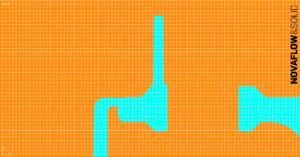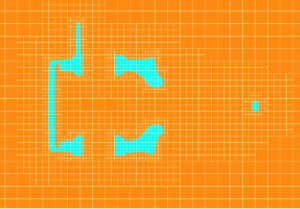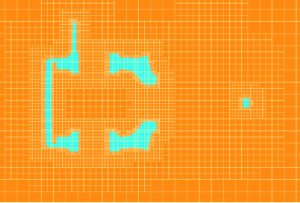Article: Higher calculation speed using irregular mesh technology in mold
This article was originally published in the April-May 2021 edition of Foundry Trade Journal. It is reprinted with the publisher’s permission.
Download this article as a pdf.
Written by Håkan Fransson, Technical Simulation Manager
Calculation time for casting process simulation is always a very interesting development point. With higher calculation speed comes the possibility of running more accurate simulations with finer elements or with more criteria selected. You can also run more simulations per day and then you have better chance to truly optimize your castings, ingates and feeding system. It also enables to run bigger castings which normally demands huge processing power to be calculated. This article is about a new development called irregular mesh in mold which is added in NovaFlow&Solid 6.5 (released on April 14, 2021).


Regular mesh (Finite Volume Method) vs. irregular mesh in mold
NovaFlow&Solid uses Finite Volume mesh method and until now the program has used the same mesh size in casting as well as in the mold, cores etc. This is called regular mesh and means that you set a structured grid with equal size of mesh over the whole calculation domain. The mesh elements are cubic but in the boundary between materials, the cube can be shared by different materials describing the casting part and boundary in between parts perfectly in shape. This is a very robust and accurate method, but it means that you have a lot of mold elements that are not necessary if compared to the mold material thickness or the rate of changed temperatures in the mold materials. Because of that, NovaCast Systems has developed a new variant of the meshing which means that in solids that are not casting material, we can have an irregular mesh. This irregular mesh is automatically generated by the system. A fine mesh (equal to casting mesh size) nearest to the casting boundary is created. Then step-wise, it is increasing the elements’ size by doubling the size after a specific equation the further away from the casting surface it gets.
Advantages using irregular mesh in mold:
• Mesh amount in mold is reduced by up to 90 %
• Calculation times reduced by 50% for solidification
• More complex tasks with more mesh in casting can be performed
• Automatic mesh generation – no manual work to optimize mesh is needed
• In the future (upcoming versions) the file sizes will also be smaller thus resulting in memory saving
How much faster is the solidification simulation using irregular mesh in mold? Here follows an example showing the potential.
Example of solidification simulation with irregular mesh:
• Regular mesh calculation time: 27 min 51 seconds.
Casting elements – 285661; Regular mold elements – 6214656
• Irregular mesh calculation time: 13 min 28 seconds.
Casting elements – 285661; Irregular mold elements – 523673
In this case, which is only solidification calculation, you reduce the calculation time by 51.6 %.
Irregular mesh combined with multi mesh:
NovaFlow&Solid uses something called multi mesh technology. Multi mesh technology switches the whole mesh grid during filling simulation or in between filling and solidification. It can also be used during a cycling simulation where you can use for example 4 mm mesh size for the first seven cycles and then in the last cycle you can have for example 2 mm mesh size.
When using multi mesh, all the results are transferred to another mesh grid resolution. One can set several steps during either mold filling and/or solidification with either smaller or bigger mesh size. Multi mesh is superb to use to reduce calculation time which means that you can have, for example, a 4 mm mesh for the filling simulation and then a finer mesh equal to 2 mm for the solidification. This enables the right accuracy at optimized speed.
With the new irregular mesh technology, there is a possibility to use it in combination with multi mesh technology. Here, mesh generation and recalculation of mesh grid during simulation is completely automatic.
The interesting thing is that it seems to be an even higher effect on the calculation time when using a combination of multi mesh and irregular mesh:


6mm mesh vs. 3mm mesh
1. Regular mesh with regular multi mesh:
Mesh filling: 6 mm elements (Total elements 765 408; casting elements 40 119)
Mesh solidification: 3 mm elements (Total elements 6 168 960; casting elements 285 068)
Calculation time for mold filling: 8 min 26 sec
Calculation time for solidification: 27 min 50 sec
2. Multi mesh with irregular mesh:
Mesh filling: 6 mm elements (Total elements 104 492; casting elements 40 119)
Mesh solidification: 3 mm elements (Total elements 521 479; casting elements 285 068)
Calculation time for mold filling: 8 min 49 sec
Calculation time for solidification: 10 min 44 sec
You can see a slight increase in the calculation time of mold filling for irregular mesh but a really big reduction of the calculation time for the solidification. Calculation time for solidification is reduced by 62 %.
The irregular mesh technology is more effective for simulations that have a bad casting mold ratio meaning that you have many mold elements to begin with. With many mold elements, it is high potential for reduction as well and they influence the calculation time strongly.
Since the irregular mesh is based on the casting element size, the irregular mesh will be remade also for each multi mesh step. All the results are then transferred from the old mesh to the new mesh. The whole process is done by a scheme that you setup in the pre-processor. It is fully automatic.
As a summary one can say that an already fast program has become even faster.
Back to all news